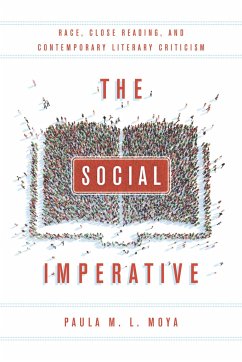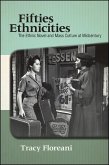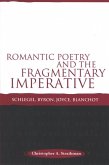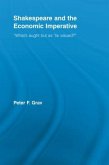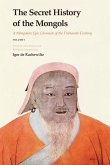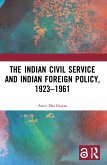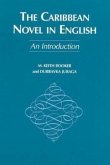- Broschiertes Buch
- Merkliste
- Auf die Merkliste
- Bewerten Bewerten
- Teilen
- Produkt teilen
- Produkterinnerung
- Produkterinnerung
This book elaborates the social-psychological concept of schema while championing the literary critical practice of close reading to show how literature reflects, promotes, and contests pervasive sociocultural ideas like race, ethnicity, gender, and sexuality.
Andere Kunden interessierten sich auch für
![Fifties Ethnicities Fifties Ethnicities]() Tracy FloreaniFifties Ethnicities39,99 €
Tracy FloreaniFifties Ethnicities39,99 €![Romantic Poetry and the Fragmentary Imperative Romantic Poetry and the Fragmentary Imperative]() Christopher A StrathmanRomantic Poetry and the Fragmentary Imperative40,99 €
Christopher A StrathmanRomantic Poetry and the Fragmentary Imperative40,99 €![Shakespeare and the Economic Imperative Shakespeare and the Economic Imperative]() Peter F. GravShakespeare and the Economic Imperative81,99 €
Peter F. GravShakespeare and the Economic Imperative81,99 €![The Secret History of the Mongols (2 Vols) The Secret History of the Mongols (2 Vols)]() Igor de RachewiltzThe Secret History of the Mongols (2 Vols)204,99 €
Igor de RachewiltzThe Secret History of the Mongols (2 Vols)204,99 €![The New Land The New Land]() Richard ChadbourneThe New Land35,99 €
Richard ChadbourneThe New Land35,99 €![The Indian Civil Service and Indian Foreign Policy, 1923-1961 The Indian Civil Service and Indian Foreign Policy, 1923-1961]() Amit Das GuptaThe Indian Civil Service and Indian Foreign Policy, 1923-196166,99 €
Amit Das GuptaThe Indian Civil Service and Indian Foreign Policy, 1923-196166,99 €![The Caribbean Novel in English The Caribbean Novel in English]() Dubravka JuragaThe Caribbean Novel in English53,99 €
Dubravka JuragaThe Caribbean Novel in English53,99 €-
-
-
This book elaborates the social-psychological concept of schema while championing the literary critical practice of close reading to show how literature reflects, promotes, and contests pervasive sociocultural ideas like race, ethnicity, gender, and sexuality.
Hinweis: Dieser Artikel kann nur an eine deutsche Lieferadresse ausgeliefert werden.
Hinweis: Dieser Artikel kann nur an eine deutsche Lieferadresse ausgeliefert werden.
Produktdetails
- Produktdetails
- Verlag: Stanford University Press
- Seitenzahl: 224
- Erscheinungstermin: 23. Dezember 2015
- Englisch
- Abmessung: 228mm x 153mm x 15mm
- Gewicht: 310g
- ISBN-13: 9780804797023
- ISBN-10: 0804797021
- Artikelnr.: 42794419
- Herstellerkennzeichnung
- Libri GmbH
- Europaallee 1
- 36244 Bad Hersfeld
- 06621 890
- Verlag: Stanford University Press
- Seitenzahl: 224
- Erscheinungstermin: 23. Dezember 2015
- Englisch
- Abmessung: 228mm x 153mm x 15mm
- Gewicht: 310g
- ISBN-13: 9780804797023
- ISBN-10: 0804797021
- Artikelnr.: 42794419
- Herstellerkennzeichnung
- Libri GmbH
- Europaallee 1
- 36244 Bad Hersfeld
- 06621 890
Paula M. L. Moya is Professor of English and, by courtesy, of Iberian and Latin American Cultures at Stanford University.
Contents and Abstracts
Introduction: Schemas and Racial Literacy
chapter abstract
After surveying responses within literary criticism to the contemporary
"crisis in the humanities," this chapter lays out the book's theoretical
framework. It begins by defining two key terms-"literature" and "close
reading"-before arguing for the importance of reconceiving literary
criticism's approach to science and the scientific method. Next, it
introduces the social psychological concept of "schema," elaborating its
significance for how literature works, before considering the relationship
between literary evaluation and objectivity. After introducing the concept
of racial literacy, the chapter argues that literature is an especially
valuable medium for learning about the way race, ethnicity, gender, and
sexuality are materialized in human lives. Because close reading engages
our cognitive-affective schemas, there may be no more effective method by
which to understand how humans make meaning about our selves and our worlds
than through the activity of close reading works of literature.
1Racism is Not Intellectual: The Dialogic Potential of Multicultural
Literature
chapter abstract
This chapter argues that because emotions are key to the doing of race, a
sustained examination of how they figure into human motivation must be
central to any attempt to move beyond the ideologies and socioeconomic
arrangements that sustain race and racism. In considering how to alter
people's emotional horizons, it draws on the work of philosophers Marilyn
Friedman and Marilyn Frye, and the literary critic M. M. Bakhtin, to
propose two avenues: 1) interracial friendships; and 2) the teaching of
multicultural literature. Friendships across difference can be rich
contexts for learning about the structural inequalities maintained by race,
while literature is a medium through which the social order can be
imaginatively examined and reshaped. Both friendships and literature have
the potential to move people emotionally by activating people's structures
of identification with, and empathy toward, other people.
2Not One and the Same Thing: The Ethical Relationship of Selves to Others
in Toni Morrison's Sula
chapter abstract
This chapter builds on Chapter 1 to argue that literature remains the most
significant venue through which authors and readers alike can examine the
complicated reasons people think and behave the way they do. Considering
Morrison as an ethicist in her own right, it shows how she uses paradox to
explore the dynamics that emerge when a self fails to recognize the other
as other, as a unique individual with legitimate needs and desires separate
from one's own. Because Morrison conducts her investigation in a fictional,
rather than a logical, form, she presents her reader less with an analysis
than with a dilemma-albeit one to which she offers some provisional answers
in the end. An exemplary multicultural novel, Sula teaches us about the way
race and gender shape identity, the kinds of relationships possible in
different situations, and the nature of human selves.
3Another Way to Be: Vestigial Schemas in Helena Maria Viramontes's "The
Moths" and Manuel Muñoz's "Zigzagger"
chapter abstract
This chapter illustrates the falseness of the dichotomy that has been posed
between "surface" and "symptomatic" modes of reading. It examines the
formal features of two short stories to show how an author's schemas can be
expressed in the themes, metaphors, temporal modes and narrative structures
of individual works of literature. It begins by examining the formal
features of Helena Maria Viramontes's short story "The Moths," before
discussing the historical and cultural contexts relevant to both the
setting and the writing of this short story in Chicana/o Los Angeles. It
then turns to the ancient Aztec goddess Coyolxauhqui to show how a
vestigial schema has shaped the story's imaginative potential. In a reading
of the title story of Manuel Munoz's Zigzagger, it shows how a buried
reference to a traditional Mexican American folktale prompts a
reconsideration of sexual and gender relations within the Chicana/o
community.
4Dismantling the Master's House: The Search for Decolonial Love in Junot
Díaz's "How to Date a Browngirl, Blackgirl, Whitegirl, or Halfie"
chapter abstract
This chapter reads the Pulitzer-Prize winning Dominican American author
Junot Díaz alongside black lesbian poet Audre Lorde to highlight Díaz's
indebtedness to a feminist tradition of decolonial thinking about
identity-a tradition shaped by the theorizing that took place in the 1980s
and 1990s under the conceptual framework of "women of color feminism." It
considers the place of race in Díaz's fiction to engage recent
characterizations of his work as "postrace" before elucidating key aspects
of Audre Lorde's women of color feminism. Via a close reading of Díaz's
short story "How to Date a Browngirl, Blackgirl, Whitegirl and Halfie," the
chapter highlights the corrosive effects of the racial self-hatred that
remains a notable legacy of European colonialism for people of color in the
Americas. It shows that-for all their temporal, generic, stylistic, gender
and sexual differences-Díaz and Lorde are engaged in complementary critical
and imaginative projects.
5The Misprision of Mercy: Race and Responsible Reading in Toni Morrison's A
Mercy
chapter abstract
This chapter argues that A Mercy grapples with two related phenomena in the
service of promoting racial literacy. They are: 1) race as a system of
social classification; and 2) the ethics and activities involved in reading
texts-including, but not limited to, the text of the racial other. Drawing
on scholarship by colonial American historians, the literary critic Alex
Woloch, and the philosopher Maria Lugones, it shows how the novel works at
both the thematic and formal levels. Thematically, the novel is set in
colonial America before the link between slavery and blackness was forged
to highlight the contingency of race. Formally, the novel redistributes
narrative space and narratorial power to characters with the least social
power to push against dominant structures of racial interpretation. At
stake is the role literature, and literary critics, might play in moving
readers toward more just ways of thinking and doing race.
Conclusion: Reading Race
chapter abstract
Introduction: Schemas and Racial Literacy
chapter abstract
After surveying responses within literary criticism to the contemporary
"crisis in the humanities," this chapter lays out the book's theoretical
framework. It begins by defining two key terms-"literature" and "close
reading"-before arguing for the importance of reconceiving literary
criticism's approach to science and the scientific method. Next, it
introduces the social psychological concept of "schema," elaborating its
significance for how literature works, before considering the relationship
between literary evaluation and objectivity. After introducing the concept
of racial literacy, the chapter argues that literature is an especially
valuable medium for learning about the way race, ethnicity, gender, and
sexuality are materialized in human lives. Because close reading engages
our cognitive-affective schemas, there may be no more effective method by
which to understand how humans make meaning about our selves and our worlds
than through the activity of close reading works of literature.
1Racism is Not Intellectual: The Dialogic Potential of Multicultural
Literature
chapter abstract
This chapter argues that because emotions are key to the doing of race, a
sustained examination of how they figure into human motivation must be
central to any attempt to move beyond the ideologies and socioeconomic
arrangements that sustain race and racism. In considering how to alter
people's emotional horizons, it draws on the work of philosophers Marilyn
Friedman and Marilyn Frye, and the literary critic M. M. Bakhtin, to
propose two avenues: 1) interracial friendships; and 2) the teaching of
multicultural literature. Friendships across difference can be rich
contexts for learning about the structural inequalities maintained by race,
while literature is a medium through which the social order can be
imaginatively examined and reshaped. Both friendships and literature have
the potential to move people emotionally by activating people's structures
of identification with, and empathy toward, other people.
2Not One and the Same Thing: The Ethical Relationship of Selves to Others
in Toni Morrison's Sula
chapter abstract
This chapter builds on Chapter 1 to argue that literature remains the most
significant venue through which authors and readers alike can examine the
complicated reasons people think and behave the way they do. Considering
Morrison as an ethicist in her own right, it shows how she uses paradox to
explore the dynamics that emerge when a self fails to recognize the other
as other, as a unique individual with legitimate needs and desires separate
from one's own. Because Morrison conducts her investigation in a fictional,
rather than a logical, form, she presents her reader less with an analysis
than with a dilemma-albeit one to which she offers some provisional answers
in the end. An exemplary multicultural novel, Sula teaches us about the way
race and gender shape identity, the kinds of relationships possible in
different situations, and the nature of human selves.
3Another Way to Be: Vestigial Schemas in Helena Maria Viramontes's "The
Moths" and Manuel Muñoz's "Zigzagger"
chapter abstract
This chapter illustrates the falseness of the dichotomy that has been posed
between "surface" and "symptomatic" modes of reading. It examines the
formal features of two short stories to show how an author's schemas can be
expressed in the themes, metaphors, temporal modes and narrative structures
of individual works of literature. It begins by examining the formal
features of Helena Maria Viramontes's short story "The Moths," before
discussing the historical and cultural contexts relevant to both the
setting and the writing of this short story in Chicana/o Los Angeles. It
then turns to the ancient Aztec goddess Coyolxauhqui to show how a
vestigial schema has shaped the story's imaginative potential. In a reading
of the title story of Manuel Munoz's Zigzagger, it shows how a buried
reference to a traditional Mexican American folktale prompts a
reconsideration of sexual and gender relations within the Chicana/o
community.
4Dismantling the Master's House: The Search for Decolonial Love in Junot
Díaz's "How to Date a Browngirl, Blackgirl, Whitegirl, or Halfie"
chapter abstract
This chapter reads the Pulitzer-Prize winning Dominican American author
Junot Díaz alongside black lesbian poet Audre Lorde to highlight Díaz's
indebtedness to a feminist tradition of decolonial thinking about
identity-a tradition shaped by the theorizing that took place in the 1980s
and 1990s under the conceptual framework of "women of color feminism." It
considers the place of race in Díaz's fiction to engage recent
characterizations of his work as "postrace" before elucidating key aspects
of Audre Lorde's women of color feminism. Via a close reading of Díaz's
short story "How to Date a Browngirl, Blackgirl, Whitegirl and Halfie," the
chapter highlights the corrosive effects of the racial self-hatred that
remains a notable legacy of European colonialism for people of color in the
Americas. It shows that-for all their temporal, generic, stylistic, gender
and sexual differences-Díaz and Lorde are engaged in complementary critical
and imaginative projects.
5The Misprision of Mercy: Race and Responsible Reading in Toni Morrison's A
Mercy
chapter abstract
This chapter argues that A Mercy grapples with two related phenomena in the
service of promoting racial literacy. They are: 1) race as a system of
social classification; and 2) the ethics and activities involved in reading
texts-including, but not limited to, the text of the racial other. Drawing
on scholarship by colonial American historians, the literary critic Alex
Woloch, and the philosopher Maria Lugones, it shows how the novel works at
both the thematic and formal levels. Thematically, the novel is set in
colonial America before the link between slavery and blackness was forged
to highlight the contingency of race. Formally, the novel redistributes
narrative space and narratorial power to characters with the least social
power to push against dominant structures of racial interpretation. At
stake is the role literature, and literary critics, might play in moving
readers toward more just ways of thinking and doing race.
Conclusion: Reading Race
chapter abstract
Contents and Abstracts
Introduction: Schemas and Racial Literacy
chapter abstract
After surveying responses within literary criticism to the contemporary
"crisis in the humanities," this chapter lays out the book's theoretical
framework. It begins by defining two key terms-"literature" and "close
reading"-before arguing for the importance of reconceiving literary
criticism's approach to science and the scientific method. Next, it
introduces the social psychological concept of "schema," elaborating its
significance for how literature works, before considering the relationship
between literary evaluation and objectivity. After introducing the concept
of racial literacy, the chapter argues that literature is an especially
valuable medium for learning about the way race, ethnicity, gender, and
sexuality are materialized in human lives. Because close reading engages
our cognitive-affective schemas, there may be no more effective method by
which to understand how humans make meaning about our selves and our worlds
than through the activity of close reading works of literature.
1Racism is Not Intellectual: The Dialogic Potential of Multicultural
Literature
chapter abstract
This chapter argues that because emotions are key to the doing of race, a
sustained examination of how they figure into human motivation must be
central to any attempt to move beyond the ideologies and socioeconomic
arrangements that sustain race and racism. In considering how to alter
people's emotional horizons, it draws on the work of philosophers Marilyn
Friedman and Marilyn Frye, and the literary critic M. M. Bakhtin, to
propose two avenues: 1) interracial friendships; and 2) the teaching of
multicultural literature. Friendships across difference can be rich
contexts for learning about the structural inequalities maintained by race,
while literature is a medium through which the social order can be
imaginatively examined and reshaped. Both friendships and literature have
the potential to move people emotionally by activating people's structures
of identification with, and empathy toward, other people.
2Not One and the Same Thing: The Ethical Relationship of Selves to Others
in Toni Morrison's Sula
chapter abstract
This chapter builds on Chapter 1 to argue that literature remains the most
significant venue through which authors and readers alike can examine the
complicated reasons people think and behave the way they do. Considering
Morrison as an ethicist in her own right, it shows how she uses paradox to
explore the dynamics that emerge when a self fails to recognize the other
as other, as a unique individual with legitimate needs and desires separate
from one's own. Because Morrison conducts her investigation in a fictional,
rather than a logical, form, she presents her reader less with an analysis
than with a dilemma-albeit one to which she offers some provisional answers
in the end. An exemplary multicultural novel, Sula teaches us about the way
race and gender shape identity, the kinds of relationships possible in
different situations, and the nature of human selves.
3Another Way to Be: Vestigial Schemas in Helena Maria Viramontes's "The
Moths" and Manuel Muñoz's "Zigzagger"
chapter abstract
This chapter illustrates the falseness of the dichotomy that has been posed
between "surface" and "symptomatic" modes of reading. It examines the
formal features of two short stories to show how an author's schemas can be
expressed in the themes, metaphors, temporal modes and narrative structures
of individual works of literature. It begins by examining the formal
features of Helena Maria Viramontes's short story "The Moths," before
discussing the historical and cultural contexts relevant to both the
setting and the writing of this short story in Chicana/o Los Angeles. It
then turns to the ancient Aztec goddess Coyolxauhqui to show how a
vestigial schema has shaped the story's imaginative potential. In a reading
of the title story of Manuel Munoz's Zigzagger, it shows how a buried
reference to a traditional Mexican American folktale prompts a
reconsideration of sexual and gender relations within the Chicana/o
community.
4Dismantling the Master's House: The Search for Decolonial Love in Junot
Díaz's "How to Date a Browngirl, Blackgirl, Whitegirl, or Halfie"
chapter abstract
This chapter reads the Pulitzer-Prize winning Dominican American author
Junot Díaz alongside black lesbian poet Audre Lorde to highlight Díaz's
indebtedness to a feminist tradition of decolonial thinking about
identity-a tradition shaped by the theorizing that took place in the 1980s
and 1990s under the conceptual framework of "women of color feminism." It
considers the place of race in Díaz's fiction to engage recent
characterizations of his work as "postrace" before elucidating key aspects
of Audre Lorde's women of color feminism. Via a close reading of Díaz's
short story "How to Date a Browngirl, Blackgirl, Whitegirl and Halfie," the
chapter highlights the corrosive effects of the racial self-hatred that
remains a notable legacy of European colonialism for people of color in the
Americas. It shows that-for all their temporal, generic, stylistic, gender
and sexual differences-Díaz and Lorde are engaged in complementary critical
and imaginative projects.
5The Misprision of Mercy: Race and Responsible Reading in Toni Morrison's A
Mercy
chapter abstract
This chapter argues that A Mercy grapples with two related phenomena in the
service of promoting racial literacy. They are: 1) race as a system of
social classification; and 2) the ethics and activities involved in reading
texts-including, but not limited to, the text of the racial other. Drawing
on scholarship by colonial American historians, the literary critic Alex
Woloch, and the philosopher Maria Lugones, it shows how the novel works at
both the thematic and formal levels. Thematically, the novel is set in
colonial America before the link between slavery and blackness was forged
to highlight the contingency of race. Formally, the novel redistributes
narrative space and narratorial power to characters with the least social
power to push against dominant structures of racial interpretation. At
stake is the role literature, and literary critics, might play in moving
readers toward more just ways of thinking and doing race.
Conclusion: Reading Race
chapter abstract
Introduction: Schemas and Racial Literacy
chapter abstract
After surveying responses within literary criticism to the contemporary
"crisis in the humanities," this chapter lays out the book's theoretical
framework. It begins by defining two key terms-"literature" and "close
reading"-before arguing for the importance of reconceiving literary
criticism's approach to science and the scientific method. Next, it
introduces the social psychological concept of "schema," elaborating its
significance for how literature works, before considering the relationship
between literary evaluation and objectivity. After introducing the concept
of racial literacy, the chapter argues that literature is an especially
valuable medium for learning about the way race, ethnicity, gender, and
sexuality are materialized in human lives. Because close reading engages
our cognitive-affective schemas, there may be no more effective method by
which to understand how humans make meaning about our selves and our worlds
than through the activity of close reading works of literature.
1Racism is Not Intellectual: The Dialogic Potential of Multicultural
Literature
chapter abstract
This chapter argues that because emotions are key to the doing of race, a
sustained examination of how they figure into human motivation must be
central to any attempt to move beyond the ideologies and socioeconomic
arrangements that sustain race and racism. In considering how to alter
people's emotional horizons, it draws on the work of philosophers Marilyn
Friedman and Marilyn Frye, and the literary critic M. M. Bakhtin, to
propose two avenues: 1) interracial friendships; and 2) the teaching of
multicultural literature. Friendships across difference can be rich
contexts for learning about the structural inequalities maintained by race,
while literature is a medium through which the social order can be
imaginatively examined and reshaped. Both friendships and literature have
the potential to move people emotionally by activating people's structures
of identification with, and empathy toward, other people.
2Not One and the Same Thing: The Ethical Relationship of Selves to Others
in Toni Morrison's Sula
chapter abstract
This chapter builds on Chapter 1 to argue that literature remains the most
significant venue through which authors and readers alike can examine the
complicated reasons people think and behave the way they do. Considering
Morrison as an ethicist in her own right, it shows how she uses paradox to
explore the dynamics that emerge when a self fails to recognize the other
as other, as a unique individual with legitimate needs and desires separate
from one's own. Because Morrison conducts her investigation in a fictional,
rather than a logical, form, she presents her reader less with an analysis
than with a dilemma-albeit one to which she offers some provisional answers
in the end. An exemplary multicultural novel, Sula teaches us about the way
race and gender shape identity, the kinds of relationships possible in
different situations, and the nature of human selves.
3Another Way to Be: Vestigial Schemas in Helena Maria Viramontes's "The
Moths" and Manuel Muñoz's "Zigzagger"
chapter abstract
This chapter illustrates the falseness of the dichotomy that has been posed
between "surface" and "symptomatic" modes of reading. It examines the
formal features of two short stories to show how an author's schemas can be
expressed in the themes, metaphors, temporal modes and narrative structures
of individual works of literature. It begins by examining the formal
features of Helena Maria Viramontes's short story "The Moths," before
discussing the historical and cultural contexts relevant to both the
setting and the writing of this short story in Chicana/o Los Angeles. It
then turns to the ancient Aztec goddess Coyolxauhqui to show how a
vestigial schema has shaped the story's imaginative potential. In a reading
of the title story of Manuel Munoz's Zigzagger, it shows how a buried
reference to a traditional Mexican American folktale prompts a
reconsideration of sexual and gender relations within the Chicana/o
community.
4Dismantling the Master's House: The Search for Decolonial Love in Junot
Díaz's "How to Date a Browngirl, Blackgirl, Whitegirl, or Halfie"
chapter abstract
This chapter reads the Pulitzer-Prize winning Dominican American author
Junot Díaz alongside black lesbian poet Audre Lorde to highlight Díaz's
indebtedness to a feminist tradition of decolonial thinking about
identity-a tradition shaped by the theorizing that took place in the 1980s
and 1990s under the conceptual framework of "women of color feminism." It
considers the place of race in Díaz's fiction to engage recent
characterizations of his work as "postrace" before elucidating key aspects
of Audre Lorde's women of color feminism. Via a close reading of Díaz's
short story "How to Date a Browngirl, Blackgirl, Whitegirl and Halfie," the
chapter highlights the corrosive effects of the racial self-hatred that
remains a notable legacy of European colonialism for people of color in the
Americas. It shows that-for all their temporal, generic, stylistic, gender
and sexual differences-Díaz and Lorde are engaged in complementary critical
and imaginative projects.
5The Misprision of Mercy: Race and Responsible Reading in Toni Morrison's A
Mercy
chapter abstract
This chapter argues that A Mercy grapples with two related phenomena in the
service of promoting racial literacy. They are: 1) race as a system of
social classification; and 2) the ethics and activities involved in reading
texts-including, but not limited to, the text of the racial other. Drawing
on scholarship by colonial American historians, the literary critic Alex
Woloch, and the philosopher Maria Lugones, it shows how the novel works at
both the thematic and formal levels. Thematically, the novel is set in
colonial America before the link between slavery and blackness was forged
to highlight the contingency of race. Formally, the novel redistributes
narrative space and narratorial power to characters with the least social
power to push against dominant structures of racial interpretation. At
stake is the role literature, and literary critics, might play in moving
readers toward more just ways of thinking and doing race.
Conclusion: Reading Race
chapter abstract

